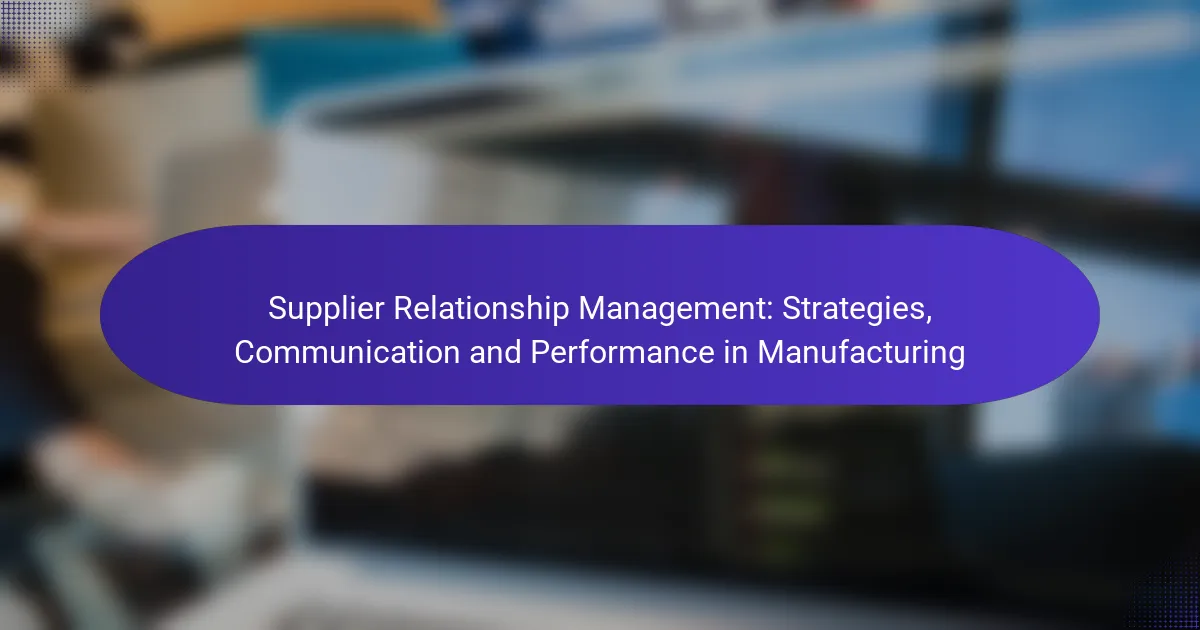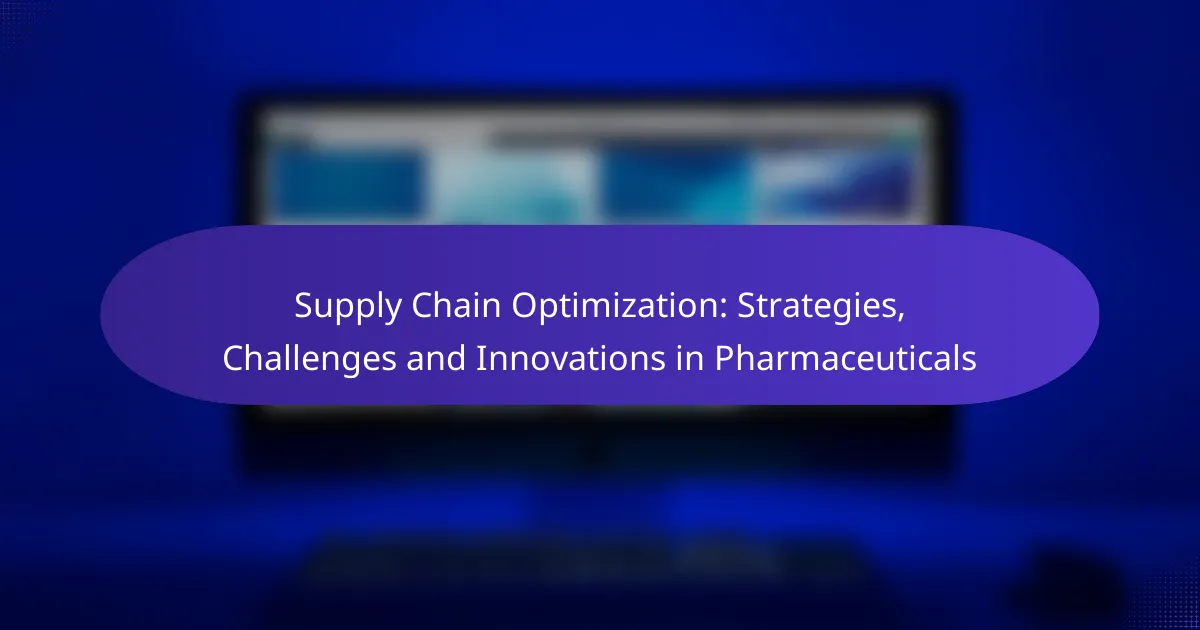Supplier Relationship Management (SRM) in manufacturing is essential for building strong partnerships that drive efficiency and performance. By implementing effective strategies that emphasize collaboration, communication, and continuous improvement, manufacturers can enhance their supply chain operations. Key performance metrics play a vital role in assessing supplier reliability and quality, ensuring that organizations achieve their operational objectives.

What are the best strategies for Supplier Relationship Management in manufacturing?
The best strategies for Supplier Relationship Management (SRM) in manufacturing focus on fostering collaboration, aligning performance metrics, managing risks, integrating technology, and promoting continuous improvement. These strategies enhance communication and efficiency, ultimately leading to stronger partnerships and better overall performance.
Collaborative planning
Collaborative planning involves working closely with suppliers to forecast demand and align production schedules. This approach helps both parties to anticipate changes and manage resources effectively, reducing lead times and inventory costs. Regular meetings and shared platforms can facilitate this collaboration.
For example, manufacturers might use joint planning sessions to discuss upcoming product launches, allowing suppliers to prepare accordingly. Establishing clear communication channels is crucial for successful collaborative planning.
Performance metrics alignment
Aligning performance metrics between manufacturers and suppliers ensures that both parties are working towards common goals. Key performance indicators (KPIs) such as on-time delivery, quality rates, and cost efficiency should be mutually agreed upon and regularly reviewed.
Using a balanced scorecard approach can help in tracking these metrics. For instance, if a supplier consistently meets quality standards but struggles with delivery times, both parties can work together to identify solutions, such as adjusting lead times or improving logistics.
Risk management frameworks
Implementing risk management frameworks is essential for identifying and mitigating potential disruptions in the supply chain. This includes assessing risks related to supplier reliability, geopolitical factors, and market fluctuations.
Manufacturers should conduct regular risk assessments and develop contingency plans. For example, diversifying the supplier base can reduce dependency on a single source, thereby minimizing risks associated with supplier failure or market instability.
Technology integration
Integrating technology into SRM processes enhances communication and data sharing between manufacturers and suppliers. Tools such as Enterprise Resource Planning (ERP) systems and Supplier Relationship Management software can streamline operations and improve visibility across the supply chain.
For instance, using cloud-based platforms allows real-time updates on inventory levels and order statuses, helping both parties respond quickly to changes. Investing in technology can lead to significant efficiency gains and cost savings.
Continuous improvement processes
Continuous improvement processes focus on regularly evaluating and enhancing supplier performance. This can be achieved through feedback loops, regular audits, and performance reviews that encourage suppliers to innovate and improve their operations.
Manufacturers should establish a culture of open communication where suppliers feel comfortable sharing challenges and suggestions. Implementing lean manufacturing principles can also drive efficiency and reduce waste, benefiting both parties in the long run.

How can effective communication enhance supplier relationships?
Effective communication is crucial for enhancing supplier relationships as it fosters trust, clarity, and collaboration. By ensuring that all parties are aligned on expectations and objectives, manufacturers can streamline operations and improve overall performance.
Regular feedback loops
Implementing regular feedback loops allows manufacturers to maintain open lines of communication with suppliers. This practice encourages continuous improvement and helps identify issues before they escalate. For example, scheduling monthly review meetings can provide a platform for discussing performance metrics and addressing concerns.
To maximize the effectiveness of feedback loops, establish clear criteria for evaluation and ensure that both parties feel comfortable sharing constructive criticism. This transparency can lead to stronger partnerships and better outcomes.
Transparent reporting systems
Transparent reporting systems are essential for tracking supplier performance and ensuring accountability. By sharing data on key performance indicators (KPIs), manufacturers can create a shared understanding of goals and progress. This could involve using dashboards that display real-time metrics related to delivery times, quality control, and compliance.
Consider adopting standardized reporting formats to simplify data sharing. This can help both parties quickly identify trends and areas for improvement, ultimately leading to enhanced collaboration.
Joint problem-solving sessions
Joint problem-solving sessions bring together teams from both the manufacturer and supplier to collaboratively address challenges. These sessions can be structured as workshops or brainstorming meetings, focusing on specific issues such as supply chain disruptions or quality concerns. Engaging both parties in the problem-solving process fosters a sense of ownership and commitment to finding solutions.
To facilitate effective joint sessions, prepare an agenda that outlines the issues to be discussed and desired outcomes. Encourage open dialogue and creative thinking, which can lead to innovative solutions that benefit both parties.

What performance metrics should be used in Supplier Relationship Management?
Key performance metrics in Supplier Relationship Management (SRM) include supplier delivery performance, quality assurance scores, and cost management effectiveness. These metrics help organizations evaluate supplier reliability, product quality, and overall financial efficiency in their supply chain operations.
Supplier delivery performance
Supplier delivery performance measures how consistently suppliers meet delivery schedules and timelines. This metric is crucial for maintaining production schedules and minimizing downtime. Organizations often track on-time delivery rates, aiming for at least 90% to ensure reliability.
To assess delivery performance, companies can use tools such as scorecards or dashboards that highlight trends over time. Regular reviews can help identify patterns, allowing for proactive management of any suppliers who fall short.
Quality assurance scores
Quality assurance scores evaluate the consistency and reliability of the products received from suppliers. This metric typically includes defect rates and compliance with quality standards. Aiming for a defect rate of less than 2% is common in many manufacturing sectors.
Implementing regular quality audits and feedback loops can enhance supplier performance. Establishing clear quality criteria and conducting periodic assessments ensures that suppliers maintain high standards, which is essential for customer satisfaction.
Cost management effectiveness
Cost management effectiveness assesses how well suppliers manage costs while delivering quality products. This metric involves analyzing total cost of ownership, including purchase price, shipping, and potential hidden costs. Effective cost management can lead to savings of 5-15% over time.
To improve cost management, companies should engage in regular negotiations and explore alternative sourcing options. Establishing long-term partnerships with suppliers can also lead to better pricing and reduced costs through economies of scale.

How to select the right suppliers for manufacturing?
Selecting the right suppliers for manufacturing involves assessing their capabilities, reliability, and alignment with your business goals. Key factors include evaluating their financial stability, production capacity, quality control processes, and communication effectiveness.
Evaluation criteria
When evaluating potential suppliers, consider criteria such as quality assurance, delivery performance, pricing, and technical capabilities. Establish a scoring system to rank suppliers based on these factors, which can help streamline the selection process.
It’s also beneficial to assess their compliance with industry standards, such as ISO certifications, which can indicate a commitment to quality and reliability. Additionally, consider their flexibility in meeting changing demands, which is crucial in a dynamic manufacturing environment.
Supplier audits
Conducting supplier audits is essential to verify their operational capabilities and adherence to your standards. These audits can include on-site visits to assess their facilities, review their quality management systems, and evaluate their workforce competency.
Regular audits help identify potential risks and areas for improvement, ensuring that suppliers maintain high performance over time. Establish a schedule for audits, typically annually or biannually, depending on the supplier’s criticality to your operations.
Market reputation assessment
Assessing a supplier’s market reputation involves researching their history, customer reviews, and industry standing. Look for feedback from other manufacturers who have worked with them to gauge their reliability and service quality.
Utilize online resources, industry reports, and trade associations to gather insights about a supplier’s reputation. A strong market presence and positive testimonials can indicate a supplier’s ability to deliver consistently and respond effectively to challenges.

What role does technology play in Supplier Relationship Management?
Technology is crucial in Supplier Relationship Management (SRM) as it enhances communication, streamlines processes, and improves data analysis. By leveraging various technological tools, manufacturers can foster stronger partnerships with suppliers, leading to better performance and efficiency.
Supply chain management software
Supply chain management (SCM) software is essential for coordinating activities between manufacturers and suppliers. These platforms facilitate real-time tracking of inventory, orders, and shipments, allowing for more efficient operations. Popular options include SAP, Oracle, and Microsoft Dynamics, which can be tailored to specific industry needs.
When selecting SCM software, consider factors such as scalability, integration capabilities with existing systems, and user-friendliness. A well-implemented SCM solution can reduce lead times and improve order accuracy, ultimately enhancing supplier relationships.
Data analytics tools
Data analytics tools play a vital role in SRM by providing insights into supplier performance and market trends. These tools can analyze historical data to identify patterns, forecast demand, and assess supplier risk. Common tools include Tableau, Power BI, and Google Analytics.
Utilizing data analytics allows manufacturers to make informed decisions regarding supplier selection and management. Regularly reviewing supplier performance metrics, such as delivery times and quality scores, can help identify areas for improvement and strengthen partnerships.
Blockchain for transparency
Blockchain technology enhances transparency in Supplier Relationship Management by providing an immutable ledger of transactions. This technology allows all parties in the supply chain to access the same information, reducing disputes and fostering trust. Companies like IBM and VeChain are leading the way in implementing blockchain solutions in manufacturing.
When considering blockchain, assess its potential to improve traceability and accountability within your supply chain. While it may require significant investment and a shift in processes, the long-term benefits of increased transparency and reduced fraud can be substantial.

How can manufacturers improve supplier collaboration?
Manufacturers can enhance supplier collaboration by fostering open communication, establishing clear expectations, and leveraging technology for better integration. Effective collaboration leads to improved efficiency, reduced costs, and stronger partnerships.
Establishing Clear Communication Channels
Clear communication channels are essential for effective supplier collaboration. Manufacturers should implement regular meetings, updates, and feedback loops to ensure that both parties are aligned on goals and expectations. Utilizing tools like project management software can facilitate real-time communication and document sharing.
Consider setting up a dedicated communication platform where suppliers can access project updates, timelines, and performance metrics. This transparency helps build trust and accountability between manufacturers and suppliers.
Setting Mutual Goals and Expectations
Defining mutual goals and expectations is crucial for successful collaboration. Manufacturers should engage suppliers in the goal-setting process to ensure that both parties understand their roles and responsibilities. This alignment can lead to improved performance and innovation.
For example, manufacturers might set targets for delivery times, quality standards, or cost reductions. Regularly reviewing these goals can help identify areas for improvement and foster a sense of shared purpose.
Leveraging Technology for Integration
Technology plays a vital role in enhancing supplier collaboration. Manufacturers can utilize supply chain management software to streamline processes and improve data sharing. This integration allows for better forecasting, inventory management, and order tracking.
Consider adopting cloud-based solutions that enable real-time access to information for both manufacturers and suppliers. This can reduce delays and errors, ultimately leading to more efficient operations and stronger partnerships.
Building Long-Term Relationships
Long-term relationships with suppliers can lead to better collaboration and mutual benefits. Manufacturers should invest time in understanding their suppliers’ capabilities and challenges. This knowledge can help in developing tailored solutions that benefit both parties.
Regularly recognizing and rewarding supplier performance can also strengthen these relationships. For instance, manufacturers might offer incentives for meeting or exceeding performance targets, fostering loyalty and commitment.



